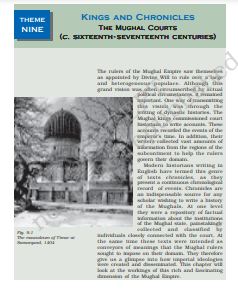‘Kings And Chronicles NCERT Class 12 History Chapter 9 Solutions‘ PDF Quick download link is given at the bottom of this article. You can see the PDF demo, size of the PDF, page numbers, and direct download Free PDF of ‘Kings And Chronicles: Mughal Courts Ncert Class 12 History Chapter 9 Exercise Solution’ using the download button.
Kings And Chronicles (Mughal Courts) NCERT Class 12 History Textbook With Answer PDF Free Download

Chapter 9: Kings And Chronicles – Mughal Courts
The name Mughal derives from Mongol. Though today the term evokes the grandeur of an empire, it was not the name the rulers of the dynasty chose for themselves.
They referred to themselves as Timurids, as descendants of the Turkish ruler Timur on the paternal side. Babur, the first Mughal ruler, was related to Ghenghiz Khan from his mother’s side.
He spoke Turkish and referred derisively to the Mongols as barbaric hordes. During the sixteenth century, Europeans used the term Mughal to describe the Indian rulers of this branch of the family.
Over the past centuries the word has been frequently used – even the name Mowgli, the young hero of Rudyard Kipling’s Jungle Book, is derived from it.
The empire was carved out of a number of regional states of India through conquests and political alliances between the Mughals and local chieftains.
The founder of the empire, Zahiruddin Babur, was driven from his Central Asian homeland, Farghana, by the warring Uzbeks.
He first established himself at Kabul and then in 1526 pushed further into the Indian subcontinent in search of territories and resources to satisfy the needs of the members of
his clan.
His successor, Nasiruddin Humayun (1530-40, 1555-56) expanded the frontiers of the empire but lost it to the Afghan leader Sher Shah Sur, who drove him into exile.
Humayun took refuge in the court of the Safavid ruler of Iran. In 1555 Humayun defeated the Surs, but died a year later.
Many consider Jalaluddin Akbar (1556-1605) the greatest of all the Mughal emperors, for he not only expanded but also consolidated his empire, making it the largest, strongest, and the richest kingdom of his time.
Akbar succeeded in extending the frontiers of the empire to the Hindukush mountains and
checked the expansionist designs of the Uzbeks of Turan (Central Asia) and the Safavids of Iran.
Akbar had three fairly able successors in Jahangir (1605-27), Shah Jahan (1628-58), and Aurangzeb (1658-1707), as their characters varied.
Under them, the territorial expansion continued, though at a much-reduced pace. The three rulers maintained and consolidated the various instruments of governance.
During the sixteenth and seventeenth centuries, the institutions of an imperial structure were created.
These included effective methods of administration and taxation. The visible center of Mughal power was the court.
Here political alliances and relationships were forged, and status and hierarchies defined.
The political system devised by the Mughals was based on a combination of military power and conscious policy to accommodate the different traditions they encountered in the subcontinent.
After 1707, following the death of Aurangzeb, the power of the dynasty diminished. In place of the vast apparatus of the empire controlled by Delhi, Agra or Lahore – the different capital cities – regional powers acquired greater autonomy.
Yet symbolically the prestige of the Mughal ruler did not lose its aura. In 1857 the last scion of this dynasty, Bahadur Shah Zafar II, was overthrown by the British.
| Author | NCERT |
| Language | English |
| No. of Pages | 34 |
| PDF Size | 799 KB |
| Category | History |
| Source/Credits | ncert.nic.in |
NCERT Solutions Class 12 History Chapter 9 Kings Chronicles Mughal Courts
1. Describe the process of manuscript production in the Mughal court.
Ans: The process of manuscript production in the Mughal court included the following:
(a) Paper-maker’s responsibility was to prepare the folios of the manuscript.
(b) Skill writers, i.e. scribes or calligraphers copied the texts.
(c) Guilders, illuminated the pages of the manuscript.
(d) Miniature painter illustrated the scene from the text.
(e) The bookbinders gathered the folio and gave it to the original shape of a book.
2. In what ways would the daily routine and special festivities associated with the Mughal court have conveyed a sense of the power of the emperor?
Ans: The daily routine and special festivities associated with the Mughal court would have conveyed a sense of the power of the emperor in the following ways :
- The emperor, after personal religious prayers, appeared on a small balcony for Jharoka darshan, before a crowd of people for darshan of the emperor. The Jharoka darshan was introduced by Akbar with the objective of broadening the acceptance of the imperial authority as part of the popular faith.
- The focus of the physical arrangement of the court was on the sovereign. It mirrored his status as the heart of society. Its centerpiece was, therefore, the throne, the takht which gave physical form to the function of the sovereign as a pillar.
- The rules regarding the status of the Mughal elites were laid down with great precision. In court, status was determined by spatial proximity to the emperor.
- Once the emperor sat on the throne, no one was permitted to move from his position or to leave without permission.
- Whenever the court or darbar was held, all who had admittance were required to make the kornish.
- The forms of salutation to the ruler indicated the person’s status in the hierarchy. Deeper prostration represented higher status.
- The diplomatic envoys like ambassadors were expected to offer an acceptable form of greeting — either by bowing deeply or kissing the ground or else to follow the Persian custom of clasping one’s hands in front of the chest.
- Special occasions such as Id, Shab-i barat anniversary of accession to the throne, and festivals — the solar and lunar birthdays of the monarch were celebrated in such a way that left a tremendous impression on visitors.
- Grand titles were adopted by the Mughal emperors at the time of coronation or after a victory over an enemy.
- Mughal coins carried the full title of the reigning emperor with regal protocal.
- A courtier always approached the emperor with gifts. He generally offered a small sum of money (nazr) or a large amount (peshkash).
- Even in diplomatic relations, gifts were regarded as a sign of honor and respect.
3. Assess the role played by women of the imperial household in the Mughal Empire
Ans: (i) The term “haram” is used to describe the domestic world of the Mughals. This word is taken from the Persian word haram, which means a sacred place.
(ii) The Mughal household consisted of the emperor’s wives and concubines, and his near and distant relatives (mother, step- and foster-mothers, sisters, daughters, daughters-in-law, aunts, children, etc.), and female servants and slaves.
(iii) Polygamy was practised widely in the Indian subcontinent, especially among the ruling groups. Both for the Rajput clans as well as the Mughals marriage was a way of cementing political relationships and forging alliances.
(iv) The gift of territory was often accompanied by the gift of a daughter in marriage. This ensured a continuing hierarchical relationship between ruling groups. It was through the link of marriage and the relationships that developed as a result that the Mughals were able to form a vast kinship network that linked them to important groups and helped to hold a vast empire together.
(v) In the Mughal household a distinction was maintained between wives who came from royal families (begams), and other wives (aghas) who were not of noble birth.
(vi) The begams, married after receiving huge amounts of cash and valuables as dowry (maahr), naturally received a higher status and greater attention from their husbands than did aghas. The concubines (aghacha or the lesser agha) occupied the lowest position in the hierarchy of females intimately related to royalty.
(vii) The agha and the aghacha could rise to the position of a begam depending on the husband’s will, and provided that he did not already have four wives.
(viii) Love and motherhood played important roles in elevating such women to the status of legally wedded wives. Apart from wives, numerous male and female slaves populated the Mughal Household. The tasks they performed varied from the most mundane to those requiring skill, tact and intelligence.
(xi)Slave eunuchs (khwajasara) moved between the external and internal life of the household as guards, servants, and also as agents for women dabbling in commerce.
- Colonialism And The Countryside PDF
- Rebels And The Raj PDF
- Colonial Cities PDF
- Mahatma Gandhi And The Nationalist Movement PDF
Kings And Chronicles Mughal Courts NCERT Textbook With Solutions PDF Free Download
